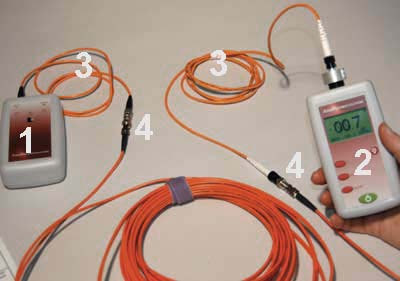A advanced optical fibre diameter analyser supports fibre manufacturing.
Wiki Article
The Duty of Optical Fiber Testing in Ensuring Top Quality and Effectiveness in Connectivity Solutions
In today's rapidly progressing electronic landscape, the importance of optical fibre testing can not be overstated, as it offers as a cornerstone for making sure the high quality and effectiveness of connectivity options. As innovation continues to development, the future of optical fiber testing positions appealing obstacles and possibilities that merit closer assessment.Relevance of Optical Fiber Screening
The significance of optical fiber screening can not be overstated in guaranteeing the integrity and efficiency of communication networks. As the foundation of modern-day telecoms, optical fibres facilitate high-speed data transmission, making their dependability vital to operational success. Examining offers as a positive action to determine possible problems such as signal loss, depletion, and physical damages, which can jeopardize network efficiency.Normal testing enables for the verification of installment high quality and the discovery of flaws that could impact information integrity - fibre testing equipment. By employing strenuous screening methods, network drivers can reduce the dangers connected with network failings, including downtime and economic losses. Optical fibre screening ensures conformity with industry standards and regulations, improving the total high quality of service offered to end-users.
Inevitably, the organized analysis of optical fibers adds to the durability and effectiveness of communication systems. It enables stakeholders to make enlightened decisions regarding upkeep, upgrades, and troubleshooting. In a landscape where information is increasingly essential, prioritizing optical fibre testing is vital to sustaining robust and reliable connection solutions, therefore sustaining the demands of modern digital environments.
Sorts Of Optical Fiber Examinations
Numerous screening approaches are used to make certain the functionality and reliability of optical fibres within communication networks. These examinations can be generally classified into 2 major kinds: installation tests and upkeep tests.Installment tests are performed promptly after the installation of optical fiber cords to verify their efficiency and stability - robotic vision. One of the most usual setup tests consist of Optical Time-Domain Reflectometry (OTDR) tests, which assess the high quality of the fiber by identifying faults or breaks, and end-to-end loss examinations, which measure the complete optical loss from one end of the fibre to the other
Maintenance examinations, on the other hand, are done occasionally to make certain continuous efficiency and detect possible problems over time. These include aesthetic evaluation, which look for physical problems or improper installations, and continuity examinations, which validate that the signal can go through the fiber without disruption.
Furthermore, progressed tests such as Polarization Setting Diffusion (PMD) and Chromatic Diffusion (CD) tests can be conducted to examine the fibre's performance under numerous conditions. By employing these varied testing techniques, technicians can preserve high standards of high quality and dependability in optical fiber networks.
Benefits of Routine Testing
Routine testing of optical fibers plays an essential duty in maintaining the general efficiency and reliability of interaction networks. By performing routine analyses, organizations can make certain that their fiber optic installments satisfy market criteria and operate efficiently. This positive technique helps to determine prospective weak points and destruction with time, enabling prompt interventions before issues intensify.
Cost-effectiveness is another benefit. By attending to minor concerns early, organizations can stay clear of the high prices connected with major repair work or system failures. Normal screening likewise fosters conformity with regulatory requirements, making certain that the network complies with required safety and security and efficiency criteria.
Usual Concerns Recognized
Identifying typical issues in optical fibre networks is vital for keeping optimum efficiency and reliability. Various factors can add ofda to disruptions, consisting of physical damage, poor installation practices, and ecological impacts.Physical damage, such as bends, breaks, or abrasions, can considerably weaken signal high quality. Incorrect installment techniques, consisting of too much stress or insufficient safeguarding of cables, may lead to raised attenuation and loss of connectivity. Furthermore, environmental variables such as temperature fluctuations, moisture access, and rodent interference can compromise the integrity of the fibre.
Port issues likewise regularly arise, with inappropriate placement or contamination causing enhanced insertion loss. Furthermore, splicing mistakes can present considerable signal deterioration if not performed with accuracy.

Resolving these usual issues through routine optical fibre screening not just improves network integrity yet likewise enhances overall performance, making sure that connection services continue to be durable and reliable.
Future Patterns in Checking
As the demand for high-speed connection proceeds to climb, the future of optical fiber screening will significantly concentrate on automation and advanced analytics. The assimilation of man-made intelligence (AI) and maker knowing (ML) in testing processes will enable more effective information evaluation and predictive maintenance, decreasing downtime and boosting general network dependability. Automated testing solutions will enhance the examination and accreditation of fibre networks, reducing human mistake and boosting screening throughput.Another substantial fad is the adoption of remote screening technologies. As the release of fibre networks expands right into remote and underserved locations, remote testing abilities will enable specialists to keep track of and diagnose network conditions without physical presence, therefore lowering functional expenses and improving response times.
Furthermore, there will be a change in the direction of more thorough testing requirements that incorporate not only typical loss measurements but also performance metrics such as latency and data transfer utilization. This holistic method will certainly assist in better network administration and optimization approaches.
As these trends advance, the optical fibre testing landscape will certainly not just enhance the high quality and effectiveness of connectivity remedies however likewise support the growing complexities of modern-day communication networks.
Final Thought
In verdict, optical fibre screening offers as an essential part in preserving the integrity and performance of interaction networks. The continuous commitment to regular testing not only improves data transmission but also aligns with sector criteria, fostering integrity in network frameworks.Report this wiki page